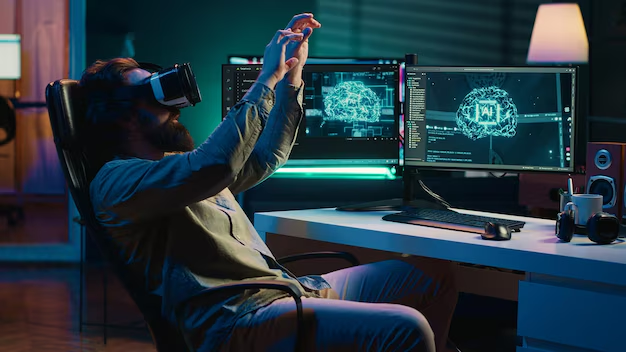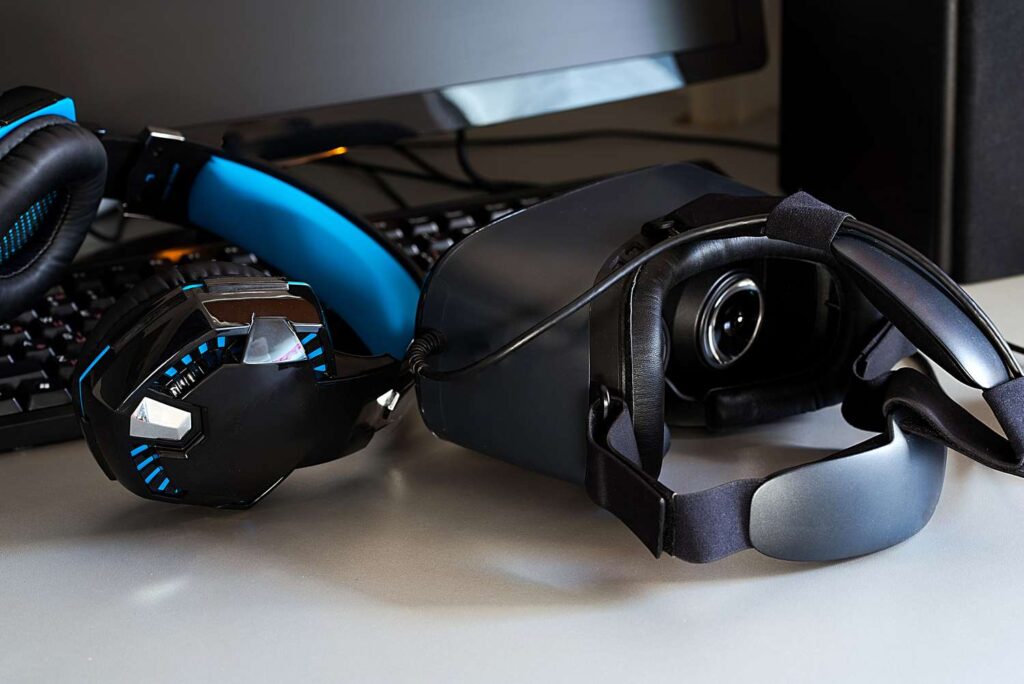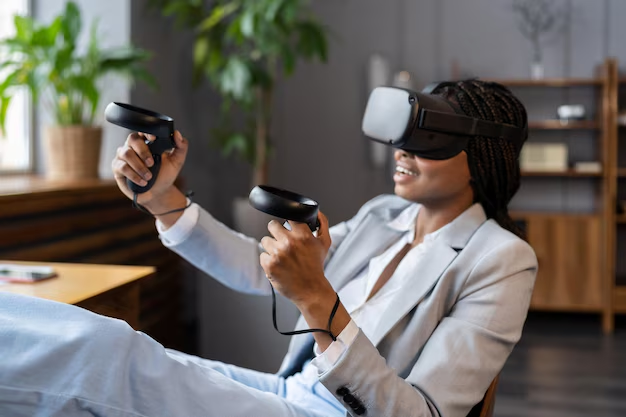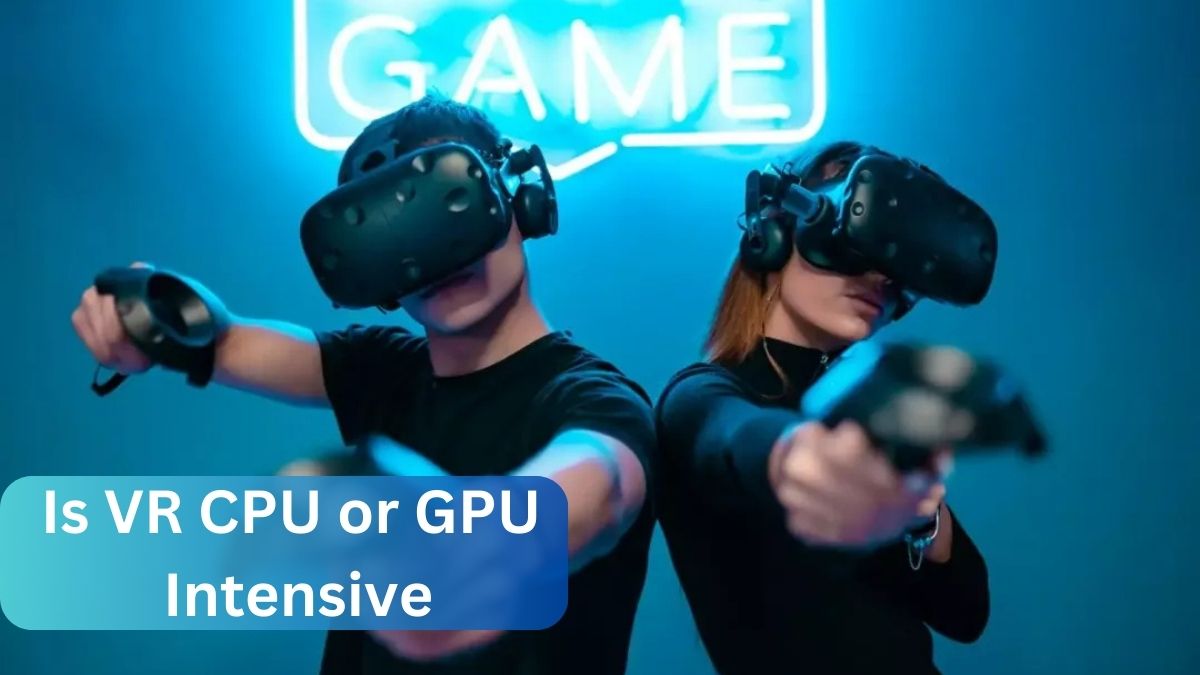Virtual Reality (VR) has brought a whole new dimension to gaming and immersive experiences, but if you’ve ever wondered what’s more crucial for VR performance—your CPU or GPU—you’re not alone. Both components play vital roles in delivering a smooth, realistic VR experience. So, let’s dive into the details and find out which of the two is more intensive for VR.
In my experience, VR is more GPU intensive because the graphics card does most of the heavy lifting, rendering high-quality visuals for both eyes at once.
In this article, we will discuss “Is VR CPU or GPU Intensive”.
Table of Contents
What is Virtual Reality (VR)?
Virtual Reality is a simulated experience where users can interact with a 3D environment in real-time. VR games, apps, and simulations demand precise and immediate responses to your actions, whether it’s moving around in a virtual space, interacting with objects, or simply turning your head. For that, your system needs powerful hardware to handle the heavy processing requirements.
Why Does VR Demand High-Performance Hardware?
Unlike regular gaming, VR has to render two separate views—one for each eye—at incredibly high resolutions and frame rates. If your hardware lags, you’ll immediately notice stuttering or blurring, which can not only break immersion but also cause discomfort like nausea. So, both your CPU and GPU have their hands full when running VR, but what exactly do they do?
Understanding the Role of CPU and GPU in VR
What Does a CPU Do in a VR Setup?
The CPU (Central Processing Unit) is like the brain of your computer. It’s responsible for processing all the instructions from your software. In VR, it handles essential tasks like game logic, physics calculations, AI interactions, and managing all the background processes that keep the game or application running smoothly.

What Does a GPU Do in a VR Setup?
The GPU (Graphics Processing Unit), on the other hand, is the muscle behind the visuals. It processes all the graphical data, rendering high-resolution images and maintaining smooth frame rates to ensure that your VR experience looks stunning. In VR, the GPU has to work twice as hard because it renders separate images for each eye, in real-time.
CPU vs. GPU: Which One is More Important for VR?
While both the CPU and GPU are essential for VR, the GPU generally plays a more prominent role. Since VR is so graphically demanding, your GPU must be powerful enough to handle rendering two high-quality images simultaneously. However, that doesn’t mean the CPU’s role is insignificant. The CPU takes care of the logic that powers the experience, and without a capable processor, you could experience slowdowns or crashes.
Read Most Important: Is Apex CPU Or GPU Intensive – Ultimate Guide 2024!
How VR Utilizes the CPU
Handling Physics and AI in VR
VR environments are often filled with complex interactions, such as picking up objects or simulating physics in real-time. These tasks are handled by the CPU, which has to process what happens when you, for example, throw a virtual object or when AI enemies respond to your actions.
Managing Game Logic and Interactions
From deciding how enemies behave to tracking the position of your VR controllers, the CPU is responsible for making sure everything in the virtual world reacts appropriately. This requires continuous processing of multiple data points and inputs.
Multitasking and Background Processes
In addition to handling the in-game logic, your CPU also manages other background tasks, like streaming or recording your VR gameplay, making it vital for an optimal experience.
How VR Utilizes the GPU
Rendering High-Resolution Graphics
Your GPU’s primary role in VR is rendering graphics. In VR, this means handling two high-resolution images simultaneously—one for each eye—which is why a powerful GPU is crucial.
Ensuring Smooth Frame Rates
For a smooth VR experience, a high frame rate is essential. Most VR headsets require at least 90 FPS (Frames Per Second) to avoid any stuttering or motion sickness, and the GPU is responsible for maintaining that performance.
Managing Textures and Lighting in VR
The GPU also handles advanced visual effects like lighting, shadows, and textures, which make the virtual world look more realistic. All these elements can significantly increase the load on the GPU, especially in complex VR environments.
Factors That Make VR CPU Intensive
Complex VR Worlds and Interactions
If the VR game or app features vast open worlds with numerous objects to interact with, your CPU will have its hands full. Complex physics and AI interactions can be particularly demanding, making the experience more CPU-heavy.

Multiplayer VR Gaming: A CPU-Heavy Experience
Multiplayer VR experiences, where the system needs to constantly communicate with a server, sync player actions, and manage additional data streams, tend to place even more demand on the CPU.
Read Most Important: GPU And CPU Not At 100 But Low Fps – Ultimate Guide 2024!
Factors That Make VR GPU Intensive
High Resolution and Refresh Rates
VR headsets typically have much higher resolution demands than regular monitors. Combine that with the need for high refresh rates (often 90Hz or higher), and your GPU is in for a workout. The better the resolution and refresh rate, the more demanding it is on the GPU.
Advanced Visual Effects and Realism in VR
As games and VR experiences push for more lifelike graphics, your GPU needs to handle more advanced shading, textures, and lighting effects, which can be highly GPU-intensive.
Finding the Right Balance Between CPU and GPU for VR
Optimizing Your Setup for the Best VR Experience
For an optimal VR experience, you need a well-balanced system. While the GPU is usually the most critical factor, having a powerful CPU ensures that your system can handle complex interactions and background tasks without hiccups.
Is a High-End GPU Enough for VR?
No, it’s not enough to just have a high-end GPU. Without a competent CPU, your system could bottleneck, causing lag or crashes, even if your GPU is more than capable. Balancing the two ensures smooth, immersive VR gameplay.
Is VR more CPU or GPU intensive Reddit
On Reddit, most users agree that VR is generally more GPU intensive. The GPU handles the rendering of high-resolution images at fast frame rates, which is crucial for a smooth VR experience.

However, the CPU still plays an important role, especially in managing physics, AI, and game logic, but it’s usually not the bottleneck unless you have a very underpowered processor.
Is iRacing CPU or GPU intensive
iRacing is considered both CPU and GPU intensive, but it tends to lean more on the CPU. This is because iRacing relies heavily on complex physics calculations, AI, and game logic, all of which require significant CPU power. However, to get the best graphical experience, a strong GPU is also necessary.
Best CPU for VR
The best CPUs for VR are typically high-end, multi-core processors with strong single-threaded performance. Examples include the Intel Core i7-12700K or AMD Ryzen 7 5800X. These processors can handle the multitasking demands of VR while ensuring smooth gameplay with minimal bottlenecks.
Read Most Important: How to Increase CPU Performance: A Comprehensive Guide 2024!
Does CPU affect VR performance
Yes, the CPU does affect VR performance. It manages tasks like physics, AI, and background processes. If your CPU isn’t powerful enough, it can lead to stuttering or crashes, even if you have a high-end GPU. A balanced system is key for optimal VR performance.
Best GPU for VR
The best GPUs for VR include the NVIDIA GeForce RTX 4080 and AMD Radeon RX 7900 XTX. These GPUs can handle the high frame rates and resolutions required by modern VR headsets like the Oculus Quest 2 and Valve Index, ensuring smooth gameplay with minimal latency.
CPU VR benchmarks
CPU VR benchmarks show that higher-end processors like the Intel Core i9-12900K or AMD Ryzen 9 7950X perform best in VR, especially in scenarios with complex physics or high player counts. These benchmarks typically assess how well a CPU handles tasks like AI processing, physics, and real-time game logic in a VR environment.
CPU or GPU bound
In most modern games and VR experiences, you’re likely to be GPU bound, meaning that the GPU is the primary component limiting performance. However, in more CPU-intensive VR titles or applications, such as ones with complex simulations, you may become CPU bound, where the CPU is the limiting factor.
CPU for VR reddit
On Reddit, many VR enthusiasts recommend high-performance CPUs like the AMD Ryzen 7 7800X3D or Intel Core i7-13700K for VR. Redditors emphasize that while the GPU is critical, a solid multi-core CPU is needed to avoid bottlenecks and handle VR’s multitasking and complex interactions.
Does VR use a lot of RAM?
Yes, VR can use a significant amount of RAM. Most modern VR systems recommend at least 16GB of RAM to handle the memory demands of running both the VR environment and any background processes simultaneously.
Is V-Ray CPU or GPU intensive?
V-Ray can be either CPU-intensive or GPU-intensive, depending on the rendering mode chosen. The CPU-based rendering mode relies on multi-core processors, while the GPU rendering mode takes advantage of powerful GPUs for faster rendering times.
Is VR CPU heavy or GPU heavy?
VR is generally more GPU-heavy because it requires rendering high-quality graphics in real time. However, it can also be CPU-heavy in scenarios involving complex simulations, physics calculations, and AI.
Does VR require more CPU?
VR requires a capable CPU, but it’s typically the GPU that carries the heavier load. A decent CPU ensures smooth game logic, physics, and multitasking, but VR’s visual performance relies more on the GPU.
Is virtualization CPU-intensive?
Yes, virtualization is typically CPU-intensive because it involves creating and managing multiple virtual environments. Running virtual machines simultaneously places a heavy load on the CPU, especially when running high-performance applications.
Is CPU or RAM more important for virtual machines?
Both are important, but CPU generally has a more significant impact on performance in virtual machines. More RAM helps with running multiple VMs or memory-hungry applications, but the CPU determines the overall processing power.
How much CPU does a virtual machine use?
The CPU usage of a virtual machine depends on its configuration and the workload it’s running. Generally, it can consume a significant amount of CPU power, especially when running heavy applications or multiple VMs simultaneously.
Is 1080p more CPU or GPU intensive?

1080p resolution is typically more GPU-intensive, as the GPU is responsible for rendering the graphics. However, if the game or application has complex AI or physics, the CPU may still be a limiting factor.
Why is 4K less CPU-intensive?
4K gaming is less CPU-intensive because most of the load shifts to the GPU to handle the high-resolution rendering. The CPU’s role remains relatively stable, while the GPU does the heavy lifting at higher resolutions.
Read Most Important: Why Your PCIe Card Stopped Working After a CPU Upgrade – Read Important Details!
FAQs
What type of CPU is best for VR?
A multi-core CPU with high clock speeds, like an Intel i7 or AMD Ryzen 7, is ideal for VR gaming.
Do VR games need a lot of RAM?
Yes, most VR games recommend at least 16GB of RAM for optimal performance.
Can I use an older GPU for VR?
It depends on the GPU’s power. Some older GPUs may struggle to meet the high frame rate and resolution demands of modern VR.
What’s the recommended refresh rate for VR headsets?
A refresh rate of at least 90Hz is recommended to avoid motion sickness and ensure smooth gameplay.
Is VR more demanding than regular gaming?
Yes, VR typically requires more from both your CPU and GPU because it needs to render two high-quality images simultaneously and at high frame rates.
Conclusion
In the debate of whether VR is more CPU or GPU intensive, the GPU generally takes the crown. VR requires extremely high-quality graphics to be rendered at fast speeds, making the GPU a vital component. However, the CPU also plays a critical role, particularly when it comes to managing interactions, physics, and multitasking. Ultimately, both are essential for a seamless VR experience.
Read Most Important:

[…] Read Most Important: Is VR CPU or GPU Intensive – Ultimate Guide 2024! […]